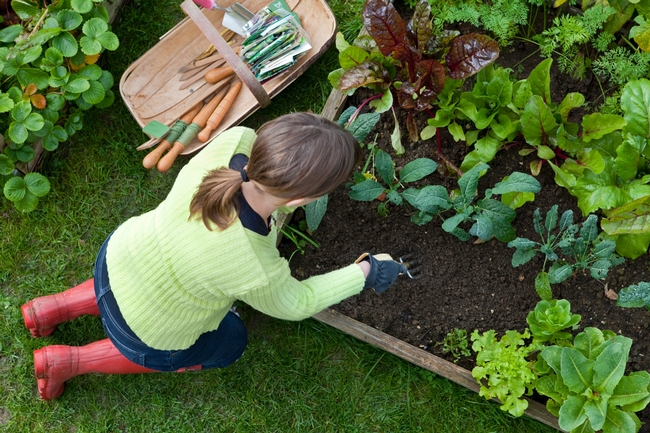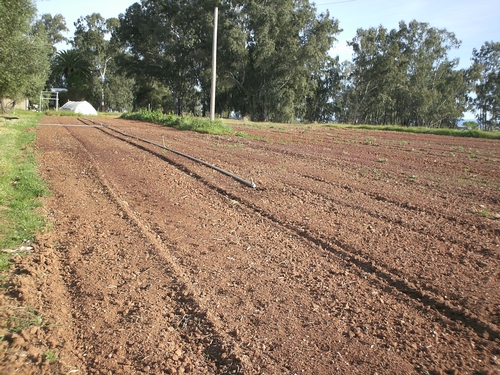
Posts Tagged: Planting
Garbanzo research update in California
From the UC Dry Bean blog on Jan. 30, 2020 With generous donations from seed companies and support from the California Dry Bean Advisory Board, we're working on two research projects in garbanzo beans this year. One is focusing on the herbicide Tough 5EC (pyridate) for broadleaf weed...
Fall Color at the Haven
Ask most folks about "fall color" and they'll picture trees turning shades of red, orange, and yellow. Here at the Haven, on the other hand, we think about all the plants that will bloom until frost. These provide honey bees with critical late-season honey-making resources; other bees and...
Ten tips for vegetable gardening during a drought
Is it possible to grow a vegetable garden when water resources are scarce and water rationing could be imposed? Water responsibly, plant carefully, and select fruit and vegetable varieties that are drought tolerant. All of these sustainable gardening practices require less water – and help ensure your family has access to a variety of nutrient rich foods.
Ten simple drought tips to reduce water use in your backyard garden
- Planting time
Plant earlier in spring and later in fall. Planting earlier in the spring season takes advantage of the warm weather and reduces exposure to high mid-summer temperatures. Planting later in the fall minimizes the use of supplemental water and takes advantage of seasonal rains to establish plants. For example, tomatoes and other nightshade crops such as peppers and eggplants, should not be planted until soil temperatures reach 55 degrees. With a warm spring this could be as early as mid-April. Remember to always use a soil thermometer for accurate soil temperature readings.
- Mulch, mulch, mulch!
A 3- to 4-inch layer of mulch can reduce watering needs by as much as 50 percent. Mulch reduces water evaporation and keeps soil temperatures down during hot summer months. Grass clippings, dried leaves, pine needles, straw and shredded bark are all examples of natural mulches which can be used to cover the soil. Hay is not recommended because it contains seeds, which yields weeds and can become a problematic option. Raised garden beds help retain water better than gardens planted in open soil.
Raised garden beds help retain water better than gardens planted in open soil. - Enclosed spaces
Gardens planted in enclosed spaces, for example a raised garden bed, retain water better than gardens planted in open soil. Plant seeds and transplants in a hexagonal "off-set" pattern rather than in straight rows. A hexagonal arrangement groups plants closer together, which provides shade from leaves, keeping soil cool and water from evaporating. - Companion planting
Companion planting is the practice of grouping crops together for mutual benefit. The Native American “three sisters” approach of planting corn, beans and squash together are the perfect example of companion planting. Tall cornstalks provide a structural support for the climbing beans, the beans return nitrogen back into the soil, and the squash spreads across the soil acting as a mulch and keeping the soil cool. - Watering times
The best time to water your garden is in the late evening and early morning hours, typically between 9 p.m. and 6 a.m. The cooler morning temperature and limited wind reduced water evaporation rates. - Water efficiently
Overhead watering with a sprinkler system is not as efficient as drip irrigation. Compared to overhead sprinklers - drip systems can reduce water usage by up to half. Install a drip irrigation system, grouping plants with similar water needs together on one drip irrigation line. Drip irrigation systems are relatively easy to install for most do-it-yourself homeowners. The UC Division of Agriculture and Natural Resources book Drip Irrigation in the Home Landscape is a great reference on the materials, design and installation of a drip system. Select the correct size garden for your family, to reduce waste from overproduction.
Select the correct size garden for your family, to reduce waste from overproduction. - Control Weeds!
Pesky weeds compete for valuable water, sunshine and soil nutrients in your garden. Remove weeds before they have an opportunity to flower or spread. Visit the UC Integrated Pest Management website for tips on controlling weeds to identify recommendations for specific weed species. - Drought Resistant Crops
Purchase varieties of fruits and vegetable that do well in hot and dry climates. Many heirloom varieties from Mediterranean regions are prized for being drought tolerant. Smaller varieties bred for containers often produce a more bountiful yield per plant than standard varieties. Avoid water hogs! Some favorite water-efficient edibles from UCCE Master Gardeners include: asparagus, chard, eggplant, mustard greens, peppers, roma tomatoes, and California native strawberries. Check with a local UCCE Master Gardener Program about which varieties are recommended for your zone. - Peak water times
Fruit and vegetables have critical periods for increased water demands. For most plants once they become established watering times and amounts can be reduced until the flowering or fruit setting process begins. An increased amount of water should be reintroduced during this time. After this initial period of fruit set water can slowly be reduced again. In some cases, reducing water can improve the flavors of your harvest (think, dry-farmed tomatoes)! - Garden size
Determine the amount of fruits and vegetables needed to feed your family, does your family have two, four, or eight members? If you overproduced and wasted crops last year - decrease the amount of plants this year. Set up a garden exchange in your neighborhood so everyone grows less but still has a great variety!
The University of California Master Gardener Program extends to the public free UC research-based information about home horticulture and pest management. In exchange for the training and materials received from the University of California, Master Gardeners perform volunteer services in a myriad of venues. If you are interested in becoming a certified UC Master Gardener contact your local UC Cooperative Extension office.
All the Way from Down Under
One of the most prominent and distant--as in far away--visitors to the Häagen-Dazs Honey Bee Haven, the half-acre bee friendly garden on Bee Biology Road, UC Davis, was Mark Leech of Launceston, Tasmania, Australia. Leech visited the garden several years ago to research his book,...

This photo of a bee foraging on a zinnia, taken in the Haagen-Dazs Honey Bee Haven, graces the front and back covers of "Bee Friendly: A Planting Guide for European Honeybees and Australia Native Pollinators." (Photo by Kathy Keatley Garvey)
Keeping my ambition in check

alone. Because my farm is small, I am the only labor most of the time. For me this is the ideal situation. It is not that I don’t like people. I love people. That is why I go to the farmers market each week. I need the feedback from my consumers to recharge my batteries and keep me focused on what is important: growing good food. That being said, I don’t want to be with people every day.
I love the solitude of farming and I love the luxury of focusing on a task from start to finish. I find that when I have employees, I don’t get to focus on tasks; instead I get to manage. I don’t really like managing and I have not made myself get good at it. The best part is that is okay. I don’t have to manage people if I don’t want to.
What I do have to do is pay close attention to how big my farm is. If I am not careful I could plant more acreage than I can take care of. How do I know this? Done it. There is nothing worse than getting too ambitious and planting so much land that none of the ground gets managed effectively. The result is that all of the crops underperform, and the farm either doesn’t make money or makes a fraction of what it could have made if less were planted and more attention were paid to a smaller space.
Success in farming is in the details, not the big picture. Sure you can plant 10 beds of carrots, but can you weed 10 beds of carrots? I can’t; I can only manage one bed at a time, but one well grown bed of carrots will make you more money than 10 weed infested beds any day. I know this, yet I often have to control my urge to over plant. I usually fail on at least one crop each year, but that is also part of the joy of farming. I never said I was perfect.
Spring is the hardest time for me as a farmer because I have so much pent up farming energy. The quiet of winter lets me recharge my batteries and once the weather warms up I am ready to go. Sometime in March I can feel the call of the land to come and farm (not too much different than the Sirens calling the sailors to the rocks). Like the sailors, I must keep my wits about me. Otherwise, I am headed for a shipwreck: a shipwreck of over ambition.
Jim Muck
Jim's Produce, Wheatland



